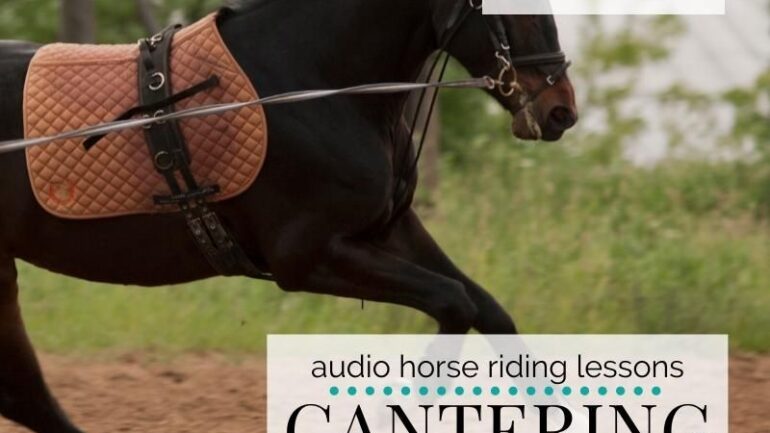Here’s a confession; for years I used to think of cantering while on the lunge as just something I did to ‘finish the session’. It was like something that I could check off a list. There was no intention behind it (only to get it done),
And with any cantering happening while on the lunge, there was definitely no thought put into using the time or gait to develop the horse.
Which, now, seems so bizarre! Why would I have even bothered with it when there was no set focus or intention?! It really does seem like madness; except for one thing…
Every week, I see so many riders making the same mistake. Cantering endless circles while on the lunge – without a single thought about why and what it might achieve or work towards…
Transitioning Into the Canter
Let’s start at the beginning with this one. I love thinking about the similarities between what happens when riding and what happens when lunging. Meaning, if you were to ride a ‘good’ transition from trot to canter, what would you consider before ‘asking’?
The transition into canter will only be as good as the quality of the trot asking for it – and the quality of the preparations for the ‘ask’.
Meaning that the trot must be moving forwards, not running. And the rider (the lunger) must invest a little time, energy, and focus in preparation for the transition itself.
Become comfortable with your half-halt while on the lunge – yes it is a thing – and spend time on coordinating and balancing your aids to ask for the transition.
Starting to Canter
When your horse does transition into the canter – resist the urge to panic! If you are not used to lunging on a consistent basis, the canter can seem very, well, fast! It is almost like a rider who is learning to canter for the first time. It can seem like things are, literally, flying by! They’re probably not!
And if your horse is ‘running’ in the canter, check out this episode HERE to help you with that.
Watching your horse canter while on the lunge often requires you to feel a little mentally uncomfortable for a time. This is due to a perceived ‘lack of control’.
Keep in mind that you have the same level of influence you had while in the trot, it is just that you may need to say things a little louder (using all of your aids) in order to be initially heard. This is a training process.
Your job will be to refine the aids and increase responsiveness so that you can be heard by your horse while in canter on the lunge.
Improving the Canter
From here, you can begin to actually work on the canter. See your aids, both natural and artificial, as being a channel for energy. Use your outside boundary to help you channel things a little more.
Become aware of the rhythm of the canter itself. Is there a distinctive 1,2,3..1,2,3.?
How can you, using your aids, help define this further?
From here, think about straightness. Are you using the lunge line to ‘slow your horse down’? Or are you using it to keep your horse while on the circle? In both cases, this will cause the energy to fall out. And, any leaks in energy will result in a canter that is far less than what it could be.
Just like when you ride, your lunge line should be used to create contact. Not steer the horse (keep it on the circle) or slow the horse down (pulling on it like an anchor).
Assess your aids, and be honest with yourself. Are you using all of the aids at your disposal in order to positively encourage a better canter from your horse, or are you just relying on the, unfortunately, obvious lunge line to ease your mental discomfort and make you feel more in control?
Be Consistent with Your Actions
Just like when you began cantering in the saddle, cantering on the lunge is probably not going to look pretty the first few times you try. It might consist of rushing and funning in wild circles. It could turn into a situation where any sort of request for a more balanced canter is met with a transition back to trot!
The key to developing your influence in the canter is to keep trying. Notice what works. And change what doesn’t.
Over time, if you can consistent with your approach, you will begin to see moments of ‘good’ canter on the lunge. Build on these. Give yourself a challenge of trying to prolong those moments just a little. And watch your efforts begin to produce real and lasting results.
Happy Lunging
Lorna
-
- Free Training for Getting Started with Lunging
- Developing Contact on the Lunge Using the Lunge Line
- Working Towards Self Carriage on the Lunge
- Retraining Your Horse Using Lunging
- Improving Your Riding Coordination and Aids While on the Lunge
- Connection – A plan for every ride going forward…
- Lunging for Riding – 4-week step by step program to transform your lunging experience
- Online community for equestrians working on their mindset & fitness
- Online Community for equestrians focusing on re-schooling horses (and ex-racehorses)

